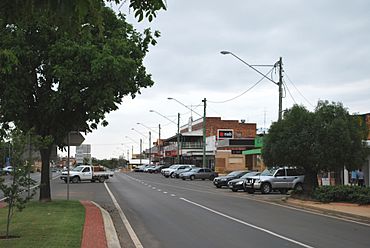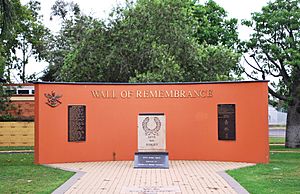Miles, Queensland facts for kids
Quick facts for kids MilesQueensland |
|||||||||||||||
|---|---|---|---|---|---|---|---|---|---|---|---|---|---|---|---|

The main street of Miles (looking towards Roma and Charleville)
|
|||||||||||||||
| Population | 1,874 (2021 census) | ||||||||||||||
| • Density | 4.2805/km2 (11.086/sq mi) | ||||||||||||||
| Established | 1878 | ||||||||||||||
| Postcode(s) | 4415 | ||||||||||||||
| Elevation | 302 m (991 ft) | ||||||||||||||
| Area | 437.8 km2 (169.0 sq mi) | ||||||||||||||
| Time zone | AEST (UTC+10:00) | ||||||||||||||
| Location |
|
||||||||||||||
| LGA(s) | Western Downs Region | ||||||||||||||
| State electorate(s) |
|
||||||||||||||
| Federal Division(s) | Maranoa | ||||||||||||||
|
|||||||||||||||
|
|||||||||||||||
Miles is a rural town and locality in the Western Downs Region, Queensland, Australia. In the 2021 census, the locality of Miles had a population of 1,874 people.
Geography
The town is on the Warrego Highway, 340 kilometres (210 mi) west of Brisbane, the state capital, 211 kilometres (131 miles) west of Toowoomba, 127 kilometres (79 miles) west of Dalby and 48 kilometres (30 miles) west of Chinchilla. It is situated 141 kilometres (88 mi) east of Roma, 221 kilometres (137 miles) east of Mitchell, 306 kilometres (190 miles) east of Morven and 406 kilometres (252 mi) east of Charleville.
History
Formerly known as Dogwood Crossing, the town is situated on Dogwood Creek, named by German explorer Ludwig Leichhardt in 1844. The town was renamed Miles in honour of the Queensland Colonial Secretary, William Miles. Miles Post Office opened on 3 January 1878.
Miles Provisional School opened on 31 May 1880, becoming Miles State School on 18 January 1886.
Holy Cross School opened in 1926. It closed on 15 December 1989.
The Miles War Memorial and Wall of Remembrance was erected by the former Murilla Shire Council and dedicated on 25 April 1967.
Miles State High School opened on 30 January 1979.
Miles Library facility opened in 2002. It houses a high-speed ISDN Internet Connection (powered through the National Broadband Network) with Brisbane through the State Library of Queensland.
Demographics
In the 2011 census, the town of Miles had a population of 1,170 people.
In the 2016 census, the locality of Miles had a population of 1,746 people.
In the 2021 census, the locality of Miles had a population of 1,874 people.
Economy
The economy of Miles is based mainly on agriculture and cropping, producing wheat, sorghum, barley and cotton. Timber production is another area of economic activity and in common with much of Western Queensland, cattle and sheep grazing, including feedlots is widespread.
A mining industry utilising rich deposits of bentonite clay is developing.
In addition, there are the following developing industries:
- Coal seam gas
- coal mining
- electricity generation
Education
Miles State School is a government primary (Early Childhood to Year 6) school for boys and girls at Constance Street (26°39′24″S 150°11′08″E / 26.6568°S 150.1856°E). In 2016, the school had an enrolment of 223 students with 18 teachers (16 full-time equivalent) with 12 non-teaching staff (9 full-time equivalent). In 2018, the school had an enrolment of 214 students with 19 teachers (17 full-time equivalent) and 14 non-teaching staff (9 full-time equivalent). It includes a special education program certified under the National Disability Insurance Scheme.
Miles State High School is a government secondary (7–12) school for boys and girls at Pine Street (26°39′13″S 150°11′06″E / 26.6535°S 150.1851°E). In 2016, the school had an enrolment of 190 students with 22 teachers (21 full-time equivalent) and 20 non-teaching staff (13 full-time equivalent). In 2018, the school had an enrolment of 182 students with 18 teachers and 17 non-teaching staff (12 full-time equivalent). It also includes a special education program certified under the National Disability Insurance Scheme
Amenities
Western Downs Regional Council operates Miles Library at Dogwood Crossing on the corner of Dawson and Murilla Streets and has a broadband ISDN Internet Connection to Brisbane (powered through the National Broadband Network) (26°39′33″S 150°11′11″E / 26.6593°S 150.1865°E).
Redeemer Lutheran Church is at 114 Murilla Street (26°39′36″S 150°11′32″E / 26.6600°S 150.1921°E).
The Miles branch of the Queensland Country Women's Association has its rooms in Corbett Drive (26°39′36″S 150°11′03″E / 26.6599°S 150.1841°E).
Attractions
Miles Historical Village Museum is at 141 Murilla Street. It is laid out in the style of town main street in an early Queensland rural town. There are 34 buildings including 15 historic structures relocated from the local area. It regarded as one of the best historical villages in Australia, and is used as a film set and special events venue, in addition to its normal operations as a museum. Every 2 years the town hosts the Miles Back to the Bush Festival in September, in and around the Miles Historical Village. The festival is the town's biggest event and features bush style entertainment with a vintage twist.
Transport
Miles is connected to Brisbane, Toowoomba and Roma by the Warrego Highway and Goondiwindi and Rockhampton by the Leichhardt Highway. Greyhound Australia operates daily bus services between Brisbane and Mount Isa via Longreach and Charleville and between Toowoomba and Rockhampton, via Miles and also to Charleville.
The Westlander train also comes through Miles twice a week, on its way between Brisbane and Charleville, at very early hours of Wednesday & Friday mornings (Westbound Service 3S86) and Thursdays & Saturdays (Eastbound Service 3987).
The town is served by the Miles Airport (IATA: WLE) which is located along the Leichhardt Highway approximately 19 km (12 mi) south of the Leichhardt and Warrego Highway intersection, Miles, Queensland, and 14 km (8.7 mi) north of the Leichhardt Highway and Roma-Condamine Road intersection, Condamine, Queensland.
Climate
Miles is on the Western Downs, at an elevation of 304 metres or 997 feet. The region around Miles has a fairly dry humid subtropical climate (Köppen Cfa) featuring hot summers with mean maximum temperatures in January of 33.4 °C or 92.1 °F, and mild to warm winters with a maximum of 19.6 °C or 67.3 °F in July. Winter mornings can be very cold and frost is common. Average rainfall is 609 millimetres or 23.98 inches, falling mainly in the period between November and March.
| Climate data for Miles (Combined sites, 1885–2014) | |||||||||||||
|---|---|---|---|---|---|---|---|---|---|---|---|---|---|
| Month | Jan | Feb | Mar | Apr | May | Jun | Jul | Aug | Sep | Oct | Nov | Dec | Year |
| Record high °C (°F) | 43.2 (109.8) |
42.1 (107.8) |
41.4 (106.5) |
36.1 (97.0) |
33.0 (91.4) |
31.1 (88.0) |
28.4 (83.1) |
36.2 (97.2) |
39.9 (103.8) |
40.7 (105.3) |
41.9 (107.4) |
43.8 (110.8) |
43.8 (110.8) |
| Mean daily maximum °C (°F) | 33.4 (92.1) |
32.4 (90.3) |
31.0 (87.8) |
27.7 (81.9) |
23.5 (74.3) |
20.0 (68.0) |
19.6 (67.3) |
21.9 (71.4) |
25.8 (78.4) |
29.0 (84.2) |
31.0 (87.8) |
32.7 (90.9) |
27.3 (81.1) |
| Mean daily minimum °C (°F) | 19.9 (67.8) |
19.6 (67.3) |
17.3 (63.1) |
12.9 (55.2) |
7.8 (46.0) |
5.4 (41.7) |
3.9 (39.0) |
5.1 (41.2) |
9.3 (48.7) |
13.4 (56.1) |
16.7 (62.1) |
18.8 (65.8) |
12.5 (54.5) |
| Record low °C (°F) | 10.9 (51.6) |
7.4 (45.3) |
4.3 (39.7) |
0.1 (32.2) |
−4.4 (24.1) |
−5.0 (23.0) |
−6.1 (21.0) |
−4.9 (23.2) |
−2.2 (28.0) |
−0.6 (30.9) |
3.4 (38.1) |
7.9 (46.2) |
−6.1 (21.0) |
| Average rainfall mm (inches) | 84.7 (3.33) |
75.4 (2.97) |
56.3 (2.22) |
35.1 (1.38) |
33.6 (1.32) |
40.6 (1.60) |
26.6 (1.05) |
31.4 (1.24) |
26.1 (1.03) |
43.8 (1.72) |
60.6 (2.39) |
94.6 (3.72) |
608.8 (23.97) |
| Average rainy days (≥ 0.2 mm) | 8.0 | 7.5 | 5.9 | 4.7 | 5.2 | 5.7 | 5.0 | 4.2 | 4.4 | 6.2 | 8.0 | 8.6 | 73.4 |
| Source: Bureau of Meteorology | |||||||||||||





